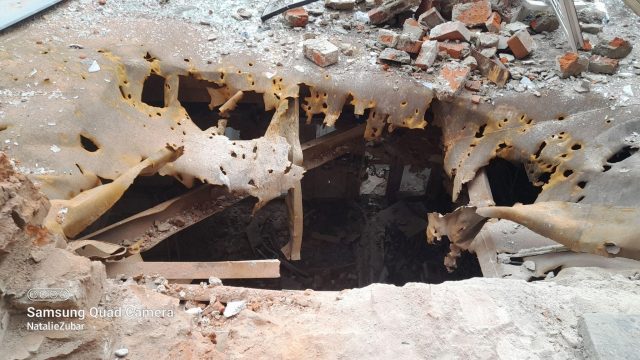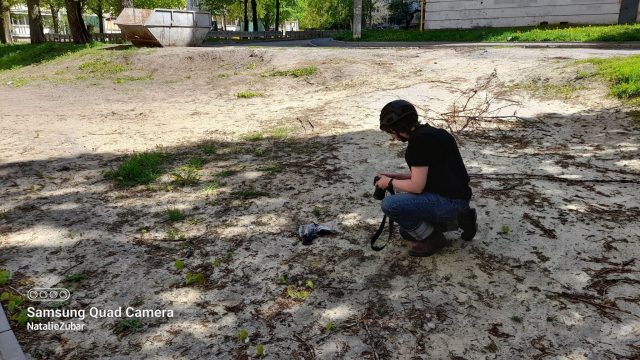The term acoustic violence was introduced in Ukraine by Maidan Monitoring Information Centre. It was the initiative of Viktor Pushkar, PhD in Psychology and Msc in Acoustics.
Back in 2016, we wrote: “One of the new mechanisms of social behaviour influence was introduced in the USSR and later inherited by Russian Federation was acoustic violence. It is permanent exposure to loud music in places of mass transit of people – transport, shops, markets and the service sector. As of 2013, typical musical product consumed in Ukraine was produced in Russian Federation. … Acoustic violence creates stress; it makes natural communication between people impossible, and leads to social atomization. [1]”
An unrecognized problem of acoustic violence
One of the results of prolonged acoustic violence is that the majority of the population … perceives shouting, hysterical and loud conversations as the norm. So regular calm conversation doesn’t attract attention anymore.
Acoustic violence is inherent in the culture of the Russian Federation in general and the musical product in particular. This is the culture of yelling, loud conversations, violation of personal boundaries. The typical public use of musical product is aimed at suppressing individuality, personal needs and private life. There is no respect for individual person within the large group considered Russian.
In 2016, we wrote “This practice is still not recognized as abnormal by the majority of the population and continues to be reproduced even in the second year of the war.” [1] Unfortunately, in July of 2022 and during the ninth year of the war this is still an under-estimated problem.
More information in our document: Framework strategy of information and communication security of Ukraine (2016). It is still up to date, as we mentioned that “The proposed measures can be used to reduce the psychological impact of war and help victims of war.” [1] They still can help. A small part of the recommendations was implemented, in particular, the draft law on acoustic violence was introduced in 2020. It is not adopted yet, but some provisions against the acoustic violence in public transport are implemented in another law, which was adopted in June of 2022 [2].
Now we faced a new challenge – acoustic terror.
Acoustic terror is a continuation of acoustic violence
“The Russians artillery targets the sleeping areas of the city, where nothing is found except for the residential buildings. The main goal of the enemy is to break the collective will of Kharkiv and intimidate Kharkiv residents. Acoustic terror tactics are used for this. The shelling is carried out in such a way that the explosions were heard throughout the city, so that the impression that the city is surrounded” is our first report on war crimes of the Russian Federation from March 5, 2022. We have interviewed the victims of acoustic terror, including the members of “Maidan Monitoring” in Kharkiv, who were unable to make the news about it themselves due to an injury, and the interviews were recorded by our colleague from Kremenchuk [3].
To maximize the acoustic impact on people, the Russian Federation uses weapons prohibited by international conventions against civilians, such as cluster shells. This weapon, in addition to damaging objects, also produces high levels of noise.
Artillery shelling, aerial and missile strikes by the Russian military on Kharkiv have been ongoing since February 24, 2022 with varying intensity. They are causing retraumatization of hundreds of thousands of people who remain in the city. According to various estimates from the city and regional authorities of Kharkiv, 500,000 to 700,000 people remained in the city. No person in the city can avoid hearing the sounds of bombs, rockets and artillery.
People emigrate because of acoustic terror
Many people were forced to leave Kharkiv because of acoustic terror, when bombs, rockets and shells were constantly falling around them.
Cluster shells use in urban landscape also creates a deceptive sound picture. Thus ta person is unable to recognize where the weapon sounds come from. Members of our team documenting Russian crimes witnessed this effect themselves on April 17, 2022. We were training in tactical medicine in a room located 150 meters from the site of the cluster projectile hit. During the shelling, the training participants incorrectly identified the place of explosion and ran closer to its epicentre. None of us were physically harmed, the training was quickly continued. We do not know how to measure the damage to our health in this case.

The urban landscape transforms the sounds a in a way that it is often difficult for people to determine the direction where the sound comes from. In most cases they hear more reflections comparatively to direct sound, so they can’t estimate distances and directions and don’t understand where and how to hide.
Poor sound isolation and absorption increases acoustic influence
This problem is particularly severe in the buildings with poor sound isolation and absorption. This is characteristic for multiple living spaces in Kharkiv. In general, realistic estimation of the war dangers is very rare skill among the civilian people. They either naturally feel scared, or they develop psychological defenses that lead them to showing off the bravery, ignoring the safety rules and exposing to high risks. The main purpose of acoustic terror by Russian Federation is to impose fear and a constant feeling of helplessness on people.
Acoustic terror affects not only people, but also animals. Pigeons and other birds die from the sounds of explosions. They fall to the ground with heartbreak. Even during the First World War, pigeon post stopped working as the birds were often injured or killed. Cats and dogs also might die from the acoustic impact of explosions.

The required technical explanation, somewhat simplified
Health damage caused by acoustic effects can be classified into several categories.
Hearing sensitivity
1) A sharp decrease in hearing sensitivity. It occurs as a result of the auditory analyser single exposure to a relatively short sound of high intensity, the pulse, starting from 140 dBA, which definitely includes ammunition explosions. The technical problem we have with pulse intensity assessment is that it requires special measurement techniques. Only some noise meters accurately record the peak of the acoustic pulse; accordingly, they are more expensive than typical household appliances, and their use requires deeper special knowledge. In addition, we should regularly monitor the sound levels to register the events with irregular distribution in time and space [4].
2) Gradual decrease in hearing sensitivity. Occurs as a result of prolonged exposure to a sound with relatively stable (stationary) statistical parameters. This includes industrial, transport and household noise with a level above 85 dBA. Some sources suggest a figure of 79 dBA as the threshold of the human acoustic reflex [5]. But we adhere to the meaning adopted in the US standards for the hearing protection of military personnel [6]. Probably, the hearing of civilians during hostilities should be protected no less. This also applies to audio and audio-visual products. Since we measure only potential harm, any media product that is unwanted by the consumer is also considered noise. If we talk about the information warfare, sound attack is also part of it.
The total hearing load from pulsed and stationary signals is calculated by adding these loads with correction coefficients. If the load exceeds the permissible levels, hearing problems occur with high probability. To avoid them, it is recommended to use personal protective means. [4]
Neurotic symptoms
3) An increase in the level of anxiety or other neurotic symptoms. Such consequences can occur with long-term background consumption of sound programs with levels of about 70 dBA, for example, a TV or radio receiver constantly turned on in the kitchen. These effects are less well studied; however, there are a number of practically verified versions regarding their harmfulness [7, 8].
Therefore, if explosions and other sounds of war produce levels below the thresholds of the acoustic reflex, they do not damage audio analyser in a direct acoustic way. But their long-term influence causes damage through the intervention of psychological factors.
4) At the social level, the aggressor uses explosions to indicate his presence, which functionally resembles the territorial behaviour of animals. We are close, don’t forget that.
Night terror
The practice of constant rocket attacks on the Kharkiv suburbs began from the last decade of May 2022. Night attacks on Kharkiv city started on June 2 from the territory of the Russian Federation (probably near Belgorod). During first three weeks, missile strikes were carried out at approximately 11:00 p.m. (between 11:00 p.m. and 12:15 a.m.), so Kharkiv musicians even dedicated a song to this habit of the aggressor.
Residents of Kharkiv were waiting for this time every day with different emotions, but most often with increased anxiety, which can lead to physical and mental exhaustion. Then the tactics changed, missile strikes took place at 1, or 4, or 2 o’clock in the morning. The Russian military moved to a “floating schedule.” These strikes might send a message from the Russian Federation to the residents of Kharkiv. “You will sleep when we allow.”
We are sure that night rocket strikes are not only aimed at destruction. The objective is also psychological terror due to the lack of normal sleep for people. The whole city and part of the suburbs hear the explosion at night. And the penetration of sound, when there are no other sounds of city noise, is greater.
Thus, the psychological and acoustic terror of “staying awake” takes on new forms – i.e., the period when a shock may occur is stretched, people get less sleep, the rhythm goes astray, and this creates additional health problems. We suspect that the Russian military may also conduct an “experiment” on the residents of Kharkiv to see how long they can endure such terror without serious psychological problems.
Methods of proof
We have not find any established methods for determining the impact of acoustic terror and presenting it at the court trial. According to experienced military journalists who worked in Chechnya and Syria, acoustic terror tactics are a common practice of the Russian military. But these testimonies cannot be considered in the criminal case.
The question “what did you hear?” or “how did you feel?” during shelling, is not part of any examination known to us. Problems with proving the destructive impact of acoustic terror of the Russian Federation on people’s health include the lack of impact assessment methods, people survey methods, and possibly the lack of a library of sounds of various projectiles, both in flight and when they hit various objects. It is not clear how to count the number of victims of the sound separately from the ones of explosion. It is likely that there were deaths of people from the direct impact of acoustic terror, but they are not counted in any way yet.
Proposed solutions
Creation of a sound terror monitoring system
Our analysis of the constant acoustic terror in Kharkiv showed that for human security it is necessary to create a sonic map of the city. We can start this project in Kharkiv and share the methodology with the other cities of Ukraine, which experience air strikes.
The proposed monitoring system would be useful for the rescuers, firefighters, investigative bodies and might be integrated into air defence system. Creating such a system is a complex task that requires an interdisciplinary approach and the cooperation of state and non-state actors in and around the city.
An approximate assessment of sound levels and their fixation, which will give us a relatively complete picture of the city’s impression of noise from shelling, is possible even with the help of free programs installed on a smart phone. However, such an indicative assessment will provide low precision of measurement. Therefore, in our opinion, cannot be recognized as evidence in the court process.
There are professional sound level monitoring systems produced in Belgium and the USA. However, such systems are expensive, their configuration must be selected for an individual task, and they require operation by specially trained personnel. Additional consultation is also required regarding the registration of this system monitoring data as evidence in the criminal process.
New standards and practices
Our Framework Strategy for Information and Communication Security of Ukraine (2016) proposed such solutions [1].
State policy of the acoustic control
It is necessary to initiate the development of a state policy of the acoustic control. A significant reduction in the acoustic impact on people will enable more comfortable environment, they will get used to the ability to speak quietly and calmly. People who live in a comfortable acoustic environment begin to notice the hysterical and hyperbolic tone of the Russian media. They are able to perceive such practices as abnormal. This creates a natural psychological border for Russian propaganda.
Such a policy should include sanctions for the use of loud music, other audio and audio-visual products that harm the physical and mental health of people in public space. The regulatory norms and control functions should be provided on both state and local level. They should be developed with participation of scientists and professional musicians.
The results of the implementation of such a policy will be realized by the citizens very quickly and will be favourably received. This is the kind of reform that does not require a lot of investment, but certainly will have a great social impact. However, as a general rule, if we prohibit something, we should introduce the new products and practices to replace the prohibited.
Our Joint Strategy of the Public Movement to Counter Information Aggression of the Russian Federation (2021) also proposed such solutions [9].
Changes of sound culture and formation of comfortable landscapes
Creation and maintenance of the infrastructure necessary for the functioning of the local music scene, in particular clubs where music lovers gather by genre, recording studios, spaces for rehearsals of ensembles. The local music scene, from amateur to professional, is able to almost completely replace sound products imported from the Russian Federation or created locally according to Russian models. Establishing horizontal connections between the musical subcultures of the cities of Ukraine, neighbouring states, and our strategic partners. Artist tours, festivals, etc.
Zero options for business affiliated with Russian Federation to work in Ukraine. No support for public events with Russian artists, either commercial or non-profitable at least till the end of war. Joint Ukrainian-Russian cultural events, according to the internationally recognized theory of conflict, will not lead to peace, but serve the purposes of aggression justification. We have observed that kind of pseudo peace building since 2014. We can provide the evidence of its negative impact on possible peace processes.
Landscape designers, in addition to the visual component, can supplement it with the sonic one. This is the architectural acoustics, a special sound atmosphere of public space, formed by a combination of natural and artificial, the location of buildings, sound reinforcement in rooms, halls and open areas.
Practices of self-regulation for professionals
For business associations we recommend to promote the use of high-quality non-intrusive instrumental music in service waiting rooms and public environments for customers and employees, and to develop acoustic hygiene standards. The owner of a club or other venue provides high quality sonification for the venue, not the disturbing loud sounds for all the surrounding neighbourhoods.
We also have to mention an Article 182 of the Code of Administrative Offenses. On the one hand, it provides formal grounds for arbitrary prosecution of persons. On the other hand, does not provide a clear definition of what constitutes a violation of noise protection standards and how do we get the evidence for it. [9] We cannot make clear distinction between those who violate noise regulation, and those who are unlucky with overly sensitive to noise neighbours. Some also live in the houses with problematic acoustics. Any sound device turned on at 90 dBA in a typical panel house may produce 60…70 dBA in a neighbouring apartment.
For people working in music education we recommend to promote alternatives to pop music from the Russian Federation. They could encourage listening and performing songs in different languages, in different genres, to promote polyphonic singing and classical music.
People involved in musical broadcasting and cultural event management could promote such music, especially for children.
Distinction between private and public audio consumption
The distinction should be made between private and public consumption of audio and audio-visual products. The state should not interfere into the private consumption of audio and audio-visual products by physical persons. But physical persons should not impose the consumption of products on others. A special mention is required for the imposition of products of the aggressor state. Their demonstration in public space should be prohibited and punished in case of the violation.
Our experience of staying in different bombed objects has shown that there is an immediate need to develop new standards for acoustic and anti-vibration protection of buildings. There is a need to construct and build the special rooms with increased protection from the war related risks. Some buildings additionally resonate to the sounds of shelling. We have witnessed a 16-story panel building literally shaken from a distant shelling of anti-aircraft missile. Also we witnessed how an apartment building shakes after a missile strike about one kilometre away.
Another requirement is mandatory calculation of sound isolation and absorption for the residential areas, offices and public venues in accordance with up to date sanitary standards. Control of the relevant acoustic parameters during the commissioning of the building. Development of recommendations for the reconstruction of acoustically problematic apartments; including the living apartments that don’t have sufficient sound isolation and (or) sound absorption.
Authors:
Nataliya Zubar and Serhiy Petrov, Kharkiv, witnesses and documenters of war crimes of the Russian Federation;
Viktor Pushkar, Kyiv, leading researcher of the Social Transformation Group, scientific and technical expertise.
#RussianWarCrimes
Literature
- Рамкова стратегія інформаційної та комунікативної безпеки України. Сайт Майдан. 09-05-2016 https://maidan.org.ua/2016/05/infostrategy2016/
- Верховна Рада України, офіційний сайт. Проект Закону про внесення змін до деяких законів України щодо підтримки національного музичного продукту та обмеження публічного використання музичного продукту держави-агресора. Включено до порядку денного: 2292-ІХ від 19.06.2022 https://zakon.rada.gov.ua/laws/show/2310-20#Text
- Воєнні злочини РФ – Харків: обстріли крилатими ракетами та акустичний терор. Сайт Майдан. 05-03-2022 https://maidan.org.ua/2022/03/voienni-zlochyny-rf-kharkiv-obstrily-krylatymy-raketamy-ta-akustychnyy-teror/
- Nakashima, Ann; Farinaccio, Rocco. Review of Weapon Noise Measurement and Damage Risk Criteria: Considerations for Auditory Protection and Performance. Military Medicine, 180, 4:402, 2015.
- Moroz, Boris. Study of the dynamic characteristics of the acoustic impedance of the human middle ear in normal and pathological conditions. Candidate of Medicine thesis, Kyiv, 1978.
- Department of Defence Design Criteria Standard Noise Limits, USA, MIL-STD-1474E, 15 April 2015 Downloaded from http://www.everyspec.com
- Малишева, Ольга. “І хутко влив до вух його отруту…” Сайт Майдан. 24-06-2014 https://maidan.org.ua/2014/06/olha-malysheva-i-hutko-vlyv-do-vuh-joho-otrutu/
- Малишева, Ольга. Як виграти інформвійну. Частина 1. Війна соціальних емоцій. Сайт Майдан. 30-06-2015 https://maidan.org.ua/2015/06/olha-malysheva-yak-vyhraty-informvijnu-chastyna-1-vijna-sotsialnyh-emotsij/
- Спільна стратегія громадського руху протидії інформаційній агресії Російської Федерації. Сайт Майдан. 15-08-2021 https://maidan.org.ua/2021/08/joint-strategy-for-a-civil-movement-to-resist-russian-information-aggression/
- Закон України Про забезпечення санітарного та епідемічного благополуччя населення. (Відомості Верховної Ради України (ВВР), 1994, № 27, ст.218) https://zakon.rada.gov.ua/laws/show/4004-12#Text





Акустичний терор в Запоріжжі. 12 жовтря 2022
Настоящему Времени рассказал глава Запорожской районной госадминистрации Олег Буряк.
Понимаете, в чем трудность ПВО в Запорожской области: она работает именно под ударами ракет С-300. Эти неточные ракеты бьют в такой разлет, что последствия страшные. Даже объекты критической инфраструктуры страдают меньше, чем жилые дома. Сгорел автозавод Skoda на набережной. То есть у нас под тотальным ударом гражданское население, которое просто уходит на ночь спать, и в эти моменты начинаются прилеты С-300. Самые сильные – с 12 ночи до двух ночи, и где-то с четырех до шести утра. Они выбирают часы, когда люди крепко спят.
https://www.currenttime.tv/a/obstrely-s-300/32079445.html